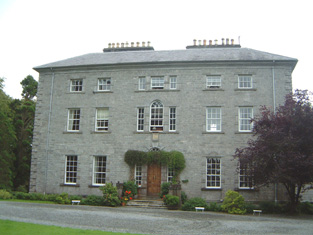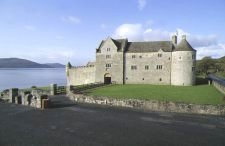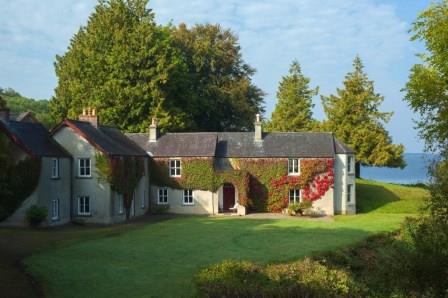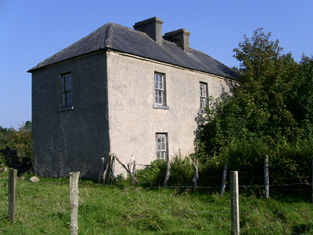Bloomfield
Houses within 10km of this house
Displaying 37 houses.
Houses within 10km of Bloomfield
Displaying 37 houses.
| House name | Description | |
|---|---|---|
| Lakeview (Kilmacallan) | Johnston states that Lakeview House was built sometime in the 1780s. It is recorded as a seat of the Weir family throughout the nineteenth century. At the time of Griffith's Valuation it was held by the representatives of William Weir and was valued at £10. Johnston asserts that the house was sold in 1863 and was occupied in the 1870s by Bernard Cogan. It is no longer extant. | |
| Heapstown | At the time of Griffith's Valuation James McTernan owned the house at Heapstown valued at £3 but part of a land holding of 100 acres. Lewis had recorded Heapstown as the seat of Martin Manning in 1837. In 1906 Heapstown was valued at £15. McTernan states that this was the house built after the Famine by Hugh McTernan. This house was eventually demolished in the 1950s. | |
| Hazelwood | Hazelwood was designed for Owen Wynne by the architect Richard Castle and built between 1720 and 1740. Reverend William Henry's account of Sligo in 1739 contains a detailed account of the house. Wilson describes it in 1786 as "a fine and elegant seat". It remained the home of the Wynne family for 200 years. At the time of Griffith's Valuation it was owned by John Wynne and was valued at £120. The estate was sold to the Land Commission in the 1920s and the house has had various uses including army accommodation, psychiatric hospital and more latterly, part of an industrial building. Though neglected it survives intact. |

|
| Markree Castle | Markree Castle was built in the early nineteenth century replacing an earlier property, which McParlan indicates was known as Mercury. McTernan notes that it is the oldest residential site in the county, having been founded by Cornet Cooper in the seventeenth century. At the time of Griffith's Valuation it was owned by Edward J. Cooper and was valued at £90. By the mid twentieth century it had fallen into disrepair but was later acquired by another member of the Cooper family. It now operates as a hotel. See http://www.markreecastle.ie/history.htm for more information. In 2014 it was offered for sale. |

|
| Clooskirt | At the time of Griffith's Valuation, Mrs. Ormsby Gore was leasing this property to William Wilson. It was then valued at £12. At the same time Ruttledge Burrowes was leasing a property valued at £4 with over 140 acres of land from the Ormsby Gore estate. Johnston states that a "model farm" was established here in the later nineteenth century. This townland is mentioned as Clooshire, in 1906, when George Ormsby Gore was the owner of the property but there is no valuation given for buildings at that time. It was subsequently lived in by the St. Lawrence family. |

|
| Rockbrook | Rockbrook was originally a Phibbs property. It later came into the possession of Abraham Martin of Cleveragh who leased it to the Cogan family and later to the Lougheed estate. It was occupied by John Lougheed at the time of Griffith's Valuation when it was valued at £3. Johnston states that the estate was divided by the Land Commission in the 1920s and that the house was sold by Mrs. Lougheed in 1938. It burnt down in 1945 and only the ruins remain today. | |
| Cloonamahon | In 1854 when the estate was offered for sale by Thomas James Meredith the house was described as "a good slated dwelling-house..somewhat out of repair, but with a little outlay, it could be made very comfortable". In 1906 Dr. Henry Tweedy was the owner of buildings valued at £50 at the site. Following the departure of the Tweedy family the property was used as a sanitorium and later a retreat centre. McTernan notes that the original house was demolished in 1976 and replaced by modern buildings. Most of the site is now occupied by a Health Service facility. | |
| Castle Neynoe/Ballysumaghan House | At the time of Griffith's Valuation, Richard B. Neynoe was leasing property at Ballysumaghan, barony of Tirerrill, to Henry Griffith, when it was valued at £30. Johnston states that Griffith changed its name to Ballysumaghan House. In 1906 it was the property of M.F.B. Stack. The house was stripped and the contents auctioned in the 1930s. Castle Neynoe was a ruin for many years but began to be restored in 2007. |

|
| Doonally | This property was sometimes known as Doonalla. At the time of Griffith's Valuation it was occupied by Mary Fury who was leasing it from Phillip Gumley when it was valued at £6. Lewis recorded it as a residence of Owen Phibbs in 1837. | |
| Lisconny | Lisconny was a property which belonged to the Phibbs family in the eighteenth century. McTernan notes that it had been purchased by them from the Mortimer family in the 1770s. It passed to the Toler family, earls of Norbury, through marriage. At the time of Griffith's Valuation, it was occupied by Bernard Owen Cogan, leasing from Lady Norbury's estate. It was then valued at £20. Lewis also records it as being occupied by the Cogan family in 1837. Johnston asserts that the Cogans acted as agents for Lady Norbury's estate in Ireland. The house was demolished early in the twentieth century. Very few traces remain except some walls of the stable yard and a building which had been an annex to the big house. | |
| Coopershill | Coopershill House was completed in 1774. McParlan described its situation as delightful in 1802. Lewis records it as the seat of Arthur Cooper in 1837. At the time of Griffith's Valuation it was occupied by Charles William Cooper and valued at £52. Charles William Cooper later succeeded his uncle as owner of the O'Hara of Annaghmore estate and henceforth Coopershill bacame an O'Hara property. He is recorded as the owner in 1894. The house is still extant and run as a guesthouse by the O'Hara family. |

|
| Castle Dargan | At the time of Griffith's Valuation, Castle Dargan was the property of John Ormsby and was valued at £14. McTernan writes that the Ormsbys had been in possession of the lands since the seventeenth century and had lived at the "old" castle before the building of the house. In 1906 it was owned by John Hosie. It continued in the Hosie family until c.2004 when it was converted into a hotel and golf course. The house has been refurbished and is in use. See www.castledargan.com |

|
| Clogherevagh | The house at Clogherevagh now forms part of St. Angela's College, a constituent college of NUI, Galway. The National Inventory of Architectural Heritage estimates that the house was built c.1890. At the time of Griffith's Valuation much of the townland was the property of John Wynne's estate. In 1894 Slater notes it as the residence of John Cochrane. |

|
| Spotfield | Spotfield appears to have been the property of the Phibbs family in the 19th century but in the 18th century may have been occupied by the White family who had intermarried with the Phibbs. At the time of Griffith's Valuation, it was leased by John Phibbs to Eccles Phibbs. The house was then valued at almost £4. McTernan notes that the house was demolished in the latter part of the twentieth century. | |
| Parke's Castle | This castle was built by Capt. Roger Parke, incorporating an old O'Rourke castle, probably in the first or second decades of the 17th century. This property eventually came into the possession of the Gore family through the marriage of Anne Parke to Sir Francis Gore. |

|
| Friarstown | In 1856 William Leith was leasing Friarstown from John Johnston at which time it was valued at £20. In the 1870s it was the address of Thomas Robert Palmer who owned over 1600 acres in Leitrim at that time. In 1814 it was the residence of Andrew Johnston and Lewis also recorded it as a seat of that family in 1837. The original house is no longer extant but modern buildings exist at the site. | |
| Drumahaire Lodge | Dromahaire Lodge was part of the Lane-Fox estate and was usually the home of the agent. During the 19th century these included D. Stewart and Joshua Kell. To the rear site are the ruins of a seventeenth-century fortified house, built by Sir William Villiers and formerly the seat of the O'Rourke family. |

|
| Sriff Cottage | Sriff Cottage was associated with the Palmer family and possibily originally used as a hunting lodge. At the time of Griffith's Valuation, it was being leased from the Lane Fox estate by Henry Palmer and was valued at £4. This house is still extant and in 2015 was offered for sale. |

|
| Tanzyfort | Tanzyfort House was built by the Cooper family in the mid-17th century and occupied by them until the completion of Coopershill House in 1774. Wilson, however, still refers to it as the seat of Arthur Cooper in 1786. Orser provides a detailed description of the layout of Tanzyfort House. | |
| Drumlease Glebe | Rev. Wilby Wynne was occupying Drumlease Glebe, barony of Dromahaire, at the time of Griffith's Valuation when it was valued at £20. McParlan includes John Carter and brothers of Drumlease on a list of "resident gentlemen of property" in 1802. |

|
| Union | In 1906 Col. E.H Cooper's estate owned a property at Union, barony of Tirerrill, valued at £7. This may the gamekeeper's cottage which is still extant at this location. |

|
| Toberscanavan House | At the time of Griffith's Valuation, James Noble was leasing this property, valued at £3 from the Cooper estate. McTernan notes that it remained in the Noble family until the later twentieth century. It is still extant but derelict. |

|
| Carrick House | Johnston states that Carrickcoola was owned by the Ormsby Gore estate but was the residence of the McLoghrey family. McTernan indicates that the original house was of two stories but that this was later replaced by a single storey building. The Ormsby Gore estate owned 22 acres of untenanted land in Carrickcoola, barony of Tirerrill, in 1906 but the buildings are not listed. At the time of Griffith's Valuation, Maj. Ormsby Gore owned the townland and was leasing a house valued at only 10s to Thomas McCloghrey together with over 130 acres. | |
| Kingston Lodge | Johnston states that Kingston Lodge was a residence of the McLoghry family. McTernan notes that it is a mid to late nineteenth century building, built by Henry McCloghry, son of Thomas McClogry of Carrickcoola. It was being leased by him from the Cooper estate at the time of Griffith's Valuation and valued at almost £4. The house remained in the McCloghry family until the 1940s and is now in a derelict state. | |
| Ardagh | At the time of Griffith's Valuation Richard Graves Brinkley held extensive property at Ardagh and Bellanascarva, barony of Tirerrill. This had formerly been part of his wife, Hester Lloyd's estate. Ardagh House was then valued at £14. Johnston states that the property at Ardagh was later lived in by Hunter family who acted as agents for the Brinkley estate. Part of the extensive farmyard of Ardagh House has been converted into residential accommodation. An extensive mill complex in the nearby townland of Bellanascarva was leased to Munds Harper at the same time where Brinkley also held a house valued at £30. |

|
| Lissycoyne | At the time of Griffith's Valuation, Patrick McDermott was leasing a property valued at £7 at Lissycoyne, barony of Tirerrill, from the Brinkley estate. It is shown as diminished in size on the 25-inch Ordnance Survey map of the 1890s. Some farm buildings are located at the site now. | |
| Carrowcrin | The Census of Elphin records Robert Burrowes as resident at Caracin in 1749. Johnston Burrowes was leasing a property valued at £3 to the Beatty family at Carrowcrin, barony of Tirerrill at the time of Griffith's Valuation. McTernan states that the property remained in the Burrows family until the early 1900s. It became vacant after the last of the family died and was eventually converted into farm-buildings. | |
| Bellamont House | Archaeological research would appear to indicate that Richard Coote had a fortified house at Collooney sometimes referred to as Bellamont House or Collooney Castle. A later structure in the town, also known as Bellamont House, is not associated with the Coote family. A possible site for Collooney Castle has been identified by Timoney drawing on earlier sources such as Terence O'Rorke. | |
| Sliganagh | At the time of Griffith's Valuation, Hugh Gray was leasing a property valued at £3 to Sarah Trimble, at Sliganagh, barony of Drumahaire. | |
| Old Castle | At the time of Griffith's Valuation, Robert Rogers & others were leasing a property at Kingsfort, barony of Tirerrill, to John Gardiner. It was valued at £10. Earlier, in 1786, Wilson refers to Kingsfort as the seat of Rev. Mr. Dodd. McTernan states that this property was originally part of the Mitchell estate and later became a police barracks. It was demolished in the 1990s. | |
| Markree Observatory | E.J. Cooper was a well-known astronomer and observer of weather patterns. He had this observatory built at Markree c. 1850. It was valued at £40 at the time of Griffith's Valuation. Though now derelict it contains some original features. The archival collection of weather observations taken at Markree is now held by the library of Met Eireann, the Irish meteorological service. |

|
| Holywell | In his 1802 description of the Wynne estate McParlan mentions that Rev. Richard Wynne was about to build at Holywell, along the shore of Lough Gill. At the time of Griffith's Valuation John Wynne was leasing the house in Cloghermore to James Patterson when it was valued at almost £7. In 1894, Slater refers to it as the seat of Captain Gethin. This house is still extant and has recently been extensively renovated. |

|
| Tully More House | Edward Perry was leasing a house valued at £5 as well as over 100 acres at Tully More, barony of Tirerrill, from the Cooper estate at the time of Griffith's Valuation. Tullymore House is still extant but unoccupied |

|
| Tully Beg House | At the time of Griffith's Valuation, Matthew Taghney leased a house valued at £1 as well as 51 acres from the Hall Dare estate. This appears to be the house known as Tully Beg House which is still extant. |

|
| Castletown (Ballysadare) | A house named Castletown appears on the 1st ed. OS Map in the townland of Cloonmacduff. At the time of Griffith's Valuation, Edward J. Cooper owned a gardener's house here valued at £1. The property is now almost completely overgrown. Historians have speculated that this may also be the location of the original seat of Lord Collooney, later acquired by the Coopers. | |
| Arnasbrack | Nicholson Ormsby Fury was leasing a house valued at £5 from the Cooper estate at the time of Griffith;s Valuation. McTernan states that it was the modern seat of the Fury family of nearby Castle Fury. In the early twentieth century the family sold their interest in the property. The house is still extant and occupied. | |
| Belvoir (Sligo) | Wilson refers to Belvoir, situated on the other side of the Garavogue river from Hazelwood, as the seat of Mr. Ormsby in 1786. By the time of Griffith's Valuation, the property here is held by John Wynne and referred to as "a servant's house", valued at £2 15s. Buildings are still extant at the site. |

